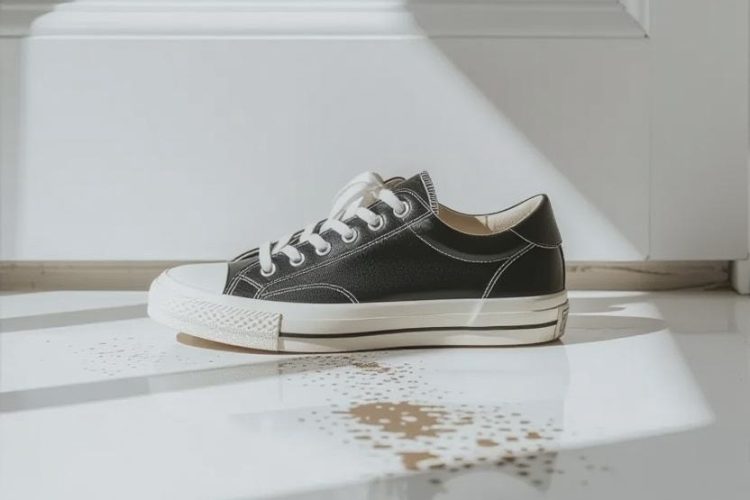Your shoes carry more than dirt—they bring toxins, bacteria, and fecal matter into your home. Up to 96% of shoe soles harbor fecal-borne bacteria like E. coli, plus drug-resistant pathogens such as MRSA and C. diff, which cause severe infections. Pesticides, heavy metals like lead, and allergens from sidewalks, lawns, and public restrooms cling to soles, raising risks of cancer, brain damage, and respiratory issues, especially for kids and pets. A no-shoes policy at the door cuts indoor pollution, improves air quality, and protects against these health risks. Designate a spot for shoes, use indoor slippers, and vacuum regularly to keep your home clean. This simple habit, common in many cultures, shields vulnerable populations and promotes a healthier living space. Leave the filth outside for a safer, cleaner home.
Long Version
The Hidden Hazards Underfoot: Why Taking Shoes Off at the Door is Essential for a Healthier Home
Imagine stepping into your home after a long day, kicking off your shoes, and sinking into the comfort of clean floors. For many cultures around the world, this isn’t just a nicety—it’s a norm rooted in hygiene practices that protect against the unseen threats lurking on shoe soles. But in households where outdoor footwear roams freely indoors, you’re not just tracking dirt; you’re inviting a cocktail of toxins, bacteria, germs, chemicals, feces, fecal matter, pollutants, allergens, heavy metals, pesticides, herbicides, microbes, pathogens, infectious agents, dust, contaminants, lead dust, toxic substances, toxic dust, and hazardous chemicals right into your living space. Shoe soles act as vectors for these invaders, turning your sanctuary into a hub of indoor pollution. Let’s dive deep into the science, health risks, and practical solutions to make your home a safer haven.
What Lurks on Your Shoe Soles: A Breakdown of Common Contaminants
Every step you take outdoors exposes your shoes to a world of filth. Studies reveal that up to 96% of shoe soles carry traces of fecal-borne bacteria, including coliform bacteria like E. coli, which can cause diarrhea-causing bacteria outbreaks. These germs aren’t isolated; they’re often accompanied by antimicrobial-resistant bacteria and drug-resistant pathogens such as Clostridium difficile (C. diff), Klebsiella pneumonia, Serratia ficaria, and MRSA—hospital-associated infectious agents that thrive in public restrooms, streets, and even grassy areas. One analysis of thousands of shoes found nearly 40% contaminated with C. diff, a resilient spore-forming bacterium that resists many household cleaners and can lead to severe intestinal and urinary tract infections.
Beyond bacteria, shoes drag in chemical threats. Pesticide residues, herbicides, fertilizers, insecticides, asphalt chemicals, and lawn chemicals cling to soles, especially after walking on treated lawns or urban sidewalks. Heavy metals like lead (a notorious heavy metal), copper, and zinc—often from lead-based paint dust or industrial runoff—pose toxic effects, including brain damage from lead exposure through hand-to-mouth contact. Research spanning 35 nations has shown these hazardous chemicals accumulate indoors via tracked-in dust, elevating cancer risk and causing eye and throat irritation. Even coronavirus particles and outdoor allergens like tree pollen, grass pollen, and weed pollen hitch a ride, exacerbating respiratory tract infections and allergies.
Fecal material on shoes is particularly alarming. Up to 99% of shoes test positive for fecal matter, with over 90% transferring to floors upon entry. This includes wound and bloodstream infections from pathogens like those causing meningitis. Urban sidewalks, often laced with animal waste, amplify this, as one study in New York City highlighted high levels of fecal bacteria in standing water that easily transfers to footwear.
The Pathways of Contamination: From Outdoors to Your Living Room
Tracking in contaminants starts the moment you step out. Public restrooms are hotspots for germy surfaces, where fecal-borne bacteria and infectious agents abound. Streets and sidewalks harbor asphalt chemicals, heavy metals, and pollutants from vehicle exhaust. Lawns treated with pesticides and fertilizers add another layer, while parks introduce allergens and microbes from soil and animal droppings. Once inside, these spread via carpet contamination, where dust settles and becomes airborne, affecting indoor air quality. Disturbing the floor can increase airborne bacteria levels by up to 10 times, turning your home into a breeding ground for the spread of germs.
Vulnerable populations—children, babies, and pets—are at heightened risk due to their proximity to floors. Babies crawling engage in hand-to-mouth exposure, ingesting lead dust or toxins that can impair development. Pets, too, suffer from toxic substances, as they groom themselves after walking on contaminated surfaces. For adults, prolonged exposure heightens health risks like respiratory tract infections or even cancer risk from accumulated hazardous chemicals.
Backed by Science: Key Studies on Shoe-Borne Threats
Decades of research underscore these dangers. A 2016 study in the Journal of Applied Microbiology confirmed shoe soles as potential vectors for pathogen transmission, including multidrug-resistant species. University of Arizona microbiologist Charles P. Gerba’s 2008 work tracked new shoes for two weeks, finding 440,000 units of bacteria, with 96% carrying coliforms like E. coli. More recently, a 2022 analysis of 30 homes showed C. diff more common on shoe bottoms than toilet seats. Environmental chemists examining indoor contaminants across nations found up to a third of household dust originates outdoors, laced with arsenic, cadmium, and lead. A 2023 study emphasized that 80% of shoes carry disease-causing pathogens, including those linked to forever chemicals and poop germs.
The Benefits of a No-Shoes Policy: Cleaner, Safer Living
Adopting a shoes-off-at-the-door rule dramatically reduces these threats. It minimizes tracking in contaminants, improving indoor air quality and cutting indoor pollution. Homes with no-shoes policies show lower levels of allergens, bacteria, and toxins, protecting against health risks like meningitis or wound infections. It also preserves carpets from contamination and wear. While some exposure to dirt builds immunity, experts agree there are better ways—like outdoor activities—than inviting germy surfaces indoors.
Practical Tips for Implementation
Start simple: Designate a spot for shoes off at the door, perhaps with a bench or mat. Use indoor shoes or slippers for support, ensuring they’re never worn outside. For guests, politely explain the hygiene benefits—many will appreciate it, especially post-pandemic. Regular vacuuming and damp mopping tackle any residual dust, but prevention is key. In cultures like those in Asia, this is standard, emphasizing clean “inside” clothes and spaces. Even in North America, where asphalt minimizes visible dirt, invisible microbes persist.
Cultural and Broader Insights
While common in Asia and parts of Europe, the no-shoes rule is gaining traction globally amid awareness of microplastics and toxins. It’s not just about cleanliness; it’s a mindful hygiene practice that respects vulnerable populations and promotes overall well-being. As one expert notes, leaving filth at the door is the easiest step to a healthier home.
In conclusion, ditching shoes indoors isn’t mere etiquette—it’s a science-backed strategy to combat the onslaught of bacteria, toxins, and feces that threaten your health. By embracing this simple change, you create a cleaner, safer environment, shielding your family from invisible dangers and enhancing everyday comfort. Next time you cross the threshold, remember: your home deserves better than the world’s underbelly.






